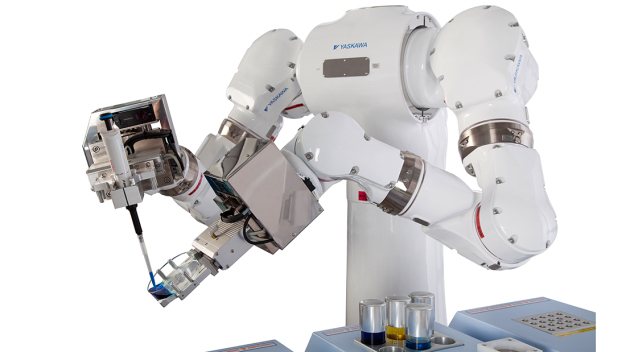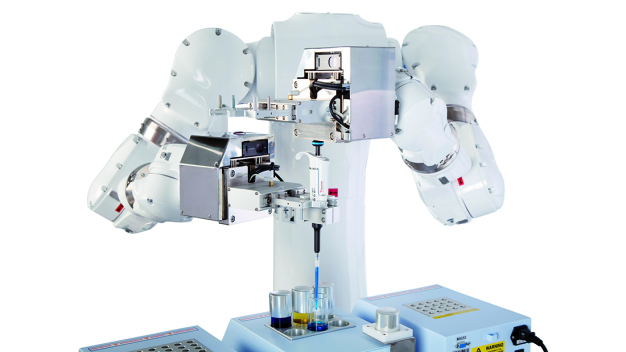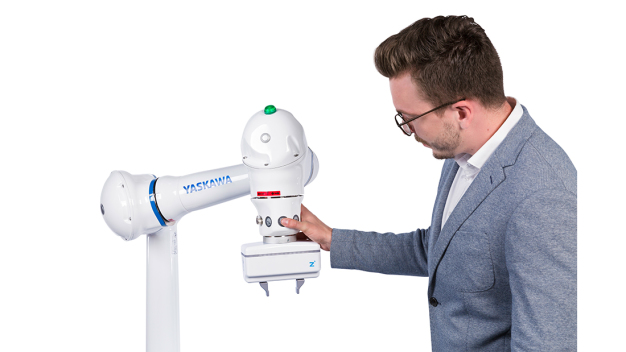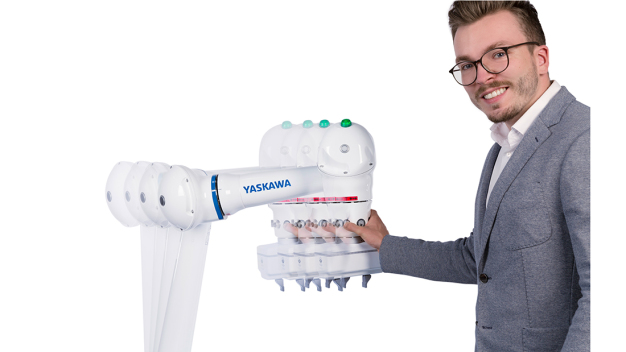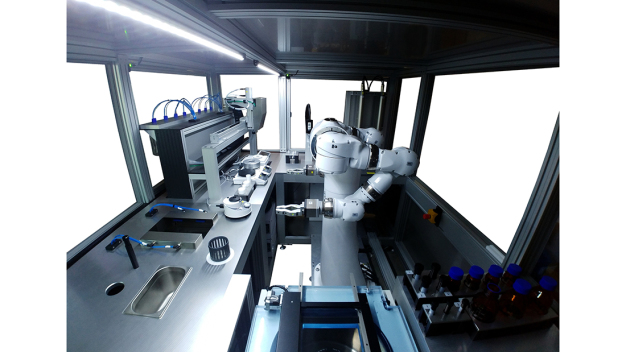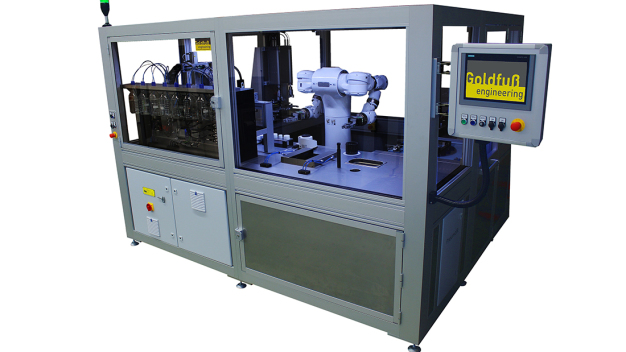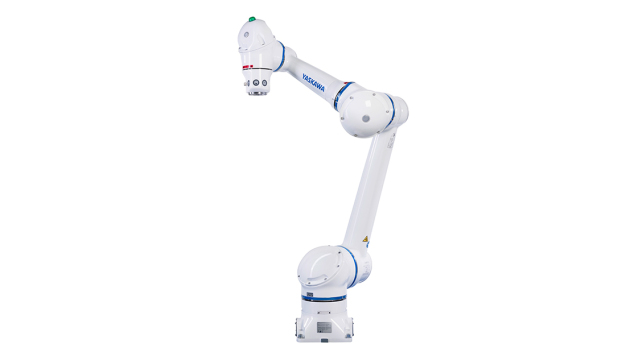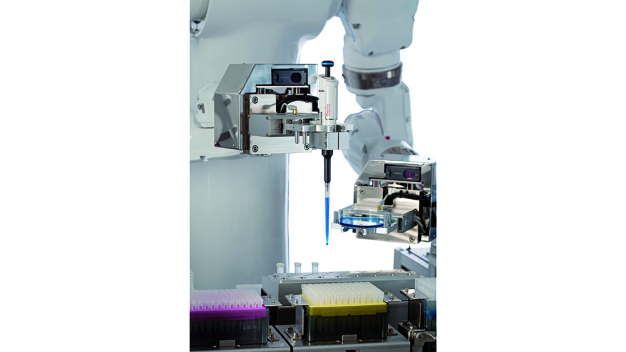Automatisierte Labortests mit Robotern
Die aktuelle Lage zeigt: Das Gesundheitswesen stößt schnell an seine Grenzen, wenn Laborkapazität fehlt, oder wenn die bestehenden Test-Installationen nicht flexibel genug umrüstbar sind für Testvarianten oder neue, abgewandelte Testverfahren. In dieser Situation bieten Laborroboter eine wertvolle Alternative zur manuellen Testdurchführung.
In der Industrie sind Roboter schon seit Langem etabliert. Doch auch in Laborumgebungen hält die Automation Einzug. In der Forschung und Entwicklung (Pharma, Chemie, Life Science und Bio- und Nuklearmedizin), der Blutanalytik oder der individuellen Kosmetikherstellung setzt man schon seit einigen Jahren erfolgreich auf Roboterlösungen, die so flexibel und universal einsetzbar sind, dass sie sich auch für klinische Infektionstests eignen. Neben der Entlastung des Laborpersonals bietet der Roboter dabei hervorragende und wiederkehrende Prozessstabilität und Qualität.
Bei der robotergestützten Automatisierung eines Laborprozesses bieten sich grundsätzlich zwei Möglichkeiten:
a) Die Teilautomatisierung, bei der der Roboter immer wiederkehrende Handhabungstätigkeiten des Laborpersonals durchführt und so eine Entlastung bringt. Der Roboter übernimmt Handhabungsaufgaben, die Prozessführung bleibt beim Laborpersonal bzw. beim Analyseautomaten.
b) Die komplette Automatisierung des Testvorgangs, inklusive Probenvorbereitung, Pipettierung, Testdurchführung einschließlich der Bedienung aller Analysegeräte durch den Roboter. Der Roboter übernimmt Prozessführung und Handhabungsaufgaben. Hier versucht man möglichst universell verwendbare Standard-Arbeitszellen aufzubauen, mit einem zweiarmigen Roboter als zentralem Element, den man auf beliebige Laborausrüstung umbauen und flexibel umprogrammieren kann. Eine solche Lösung kann Laborprozesse 24 Stunden am Tag autark und mit höchster Präzision und Wiederholgenauigkeit durchführen.
Wie schnell sind robotergestützte Automatisierungslösungen einsetzbar?
Im Falle einer Teilautomatisierung, also wenn der Roboter zu Handlingzwecken nachgerüstet werden soll, geht das mit kollaborativen Robotern sehr schnell. Die Konzeption und Neuinstallation einer vollautomatisierten Roboterzelle hingegen benötigt einige Monate. Wenn eine solche Standard-Roboterzelle jedoch einmal installiert ist, die in Frage kommenden Labor- und Analytikgeräte um den Roboter herum aufgebaut sind, und wenn im Laufe der Zeit eine Bibliothek von Bewegungsmustern gewachsen und vorhanden ist, „dann können solche Zellen schnell und einfach für neue Aufgaben umprogrammiert werden“, so Thomas Goldfuss, Geschäftsführer der Firma Goldfuss Engineering, die bereits mehrere Labor-Zellen mit Robotern von Yaskawa für namhafte Kunden umgesetzt hat.
Die schnelle Lösung: Teil-Automatisierung von Handlingaufgaben mit kollaborativem Roboter
Zur kurzfristigen Entlastung des Laborpersonals kann eine Teil-Automatisierung von Handlingaufgaben an vorhandenen manuellen Teststationen helfen. Der Roboter übernimmt wiederkehrende Bewegungen und entlastet damit das qualifizierte Laborpersonal. Dafür bietet sich ein kollaborativer Roboter an, der im direkten Kontakt mit dem Menschen eingesetzt werden und ohne Schutzzaun auskommen kann.
Ein solcher Roboter ist der MRK-fähige Motoman HC10DT von Yaskawa. Für den Einsatz im Labor sind vor allem zwei Varianten des 6-Achsers geeignet: der in der Schutzart IP67 ausgeführte und damit sowohl staub- als auch wasserdichte HC10DT IP67 und der hygienegerecht ausgeführte HC10DTF, dessen Betriebsstoffe/Getriebefette eine Lebensmittelzulassung besitzen.
Mit dem Direct Teach (DT)-Verfahren führt man den Roboterarm einfach von Punkt zu Punkt einer Bewegungssequenz. Mit Hilfe vorbelegter Tasten am Roboter bestimmt man, ob ein Greifer an einer Position geöffnet oder geschlossen werden soll. Diese Bewegungssequenz speichert man in einer Bibliothek ab, und der Roboter kann diese Sequenz beliebig oft wiederholen. Dazu sind auch ein Bediener in der Lage, der kein Roboter-Programmierexperte ist.
Die vollautomatisierte Roboter-Arbeitsstation – mit dem zweiarmigen Laborroboter CSDA10F
Ein speziell für die Laborautomatisierung entwickelter Roboter ist der zweiarmige Roboter Motoman CSDA10F von Yaskawa. Mit seiner menschenähnlichen Statur und den beiden Armen, die sowohl individuell als auch synchronisiert Bewegungen ausführen können, ist er dank multifunktionaler Werkzeuge und Greifer ausgesprochen vielseitig einsetzbar. Er arbeitet mit nahezu jeder vorhandenen Standard-Laborausrüstung und ist in der Lage, mit herkömmlicher Laborausstattung umzugehen, wie sie von Handarbeitsplätzen her bekannt sind: z. B. Petrischalen, Handpipettierern, Inkubatoren oder Reaktionsgefäßen. Automatisierungsgerechte Ausstattung, wie Pipettierer mitsamt teurer Spitzen oder Mikrotiterplatten-Bahnhöfe sind zwar hinsichtlich einer Durchsatzverbesserung hilfreich, aber nicht erforderlich.
Die vorhandenen Analytikgeräte werden, mitsamt ihrer softwaretechnischen Anbindung, übernommen, so wie sie sind, auch wenn sie eigentlich nicht für die klassische Automatisierung optimiert wurden. So sind z. B. teure Liquid-Handling-Systeme – mit ihrem kostspieligen Verbrauchsmaterial – nicht unbedingt erforderlich, da der Roboter diese Aufgabe direkt mit übernehmen kann. In seiner Labor-Arbeitsstation kann der Roboter eine Vielzahl von Aufgaben abarbeiten, die bisher dem Menschen vorbehalten schienen, wie das Öffnen und Schließen von beliebigen Reaktionsgefäßen (es müssen nicht immer Mikrotiterplatten sein), das Pipettieren und das Dosieren von Flüssigkeiten oder Pulvern, das Herstellen von Nährlösungen mit Spateln, das Einstellen und Herausnehmen von Proben sowie das Öffnen, Befüllen und Schließen von Reaktionsgefäßen, sowie die Bedienung von Geräten wie Zentrifugen, Rüttlern oder Inkubatoren. Der CSDA10F eignet sich ausgezeichnet für komplexe, standardisierte Testabläufe nach gegebenen Protokollen, die eigentlich für die manuelle Abarbeitung geschrieben wurden. Auch in der Verfahrensentwicklung, z. B. zur Definition, Absicherung und Optimierung von Prozessschritten vor dem Upscaling des Durchsatzes in einer späteren Produktionsstraße, ist der Dual-Arm-Roboter CSDA10F daher eine interessante Lösung. In größeren Installationen ist er in Japan bereits in der Biomedizin-Synthese (Cancer Drug Development) und in der chemischen Analytik (Probenaufbereitung) im Einsatz.
Der CSDA10F basiert auf einem Roboter, der sich in der Industrieautomation bereits bewährt hat. In dieser neuen Variante wurde er speziell für die Hygieneanforderungen im Laborbereich ausgelegt, z.B. durch eine besonders substanzresistente Lackierung, abwaschbares Hygienic Design, H2O2-Sterilisation und Reinraumtauglichkeit gem. ISO 14644-1.
Das Einsatzspektrum des innovativen Roboters ist dank seiner hohen Flexibilität breit gefächert – er kann schnell und einfach völlig neue Arbeitsabläufe hinzulernen. Viele charakteristische Bewegungen (Pipettieren, „Eppi“ öffnen/schließen, Mikrotiterplatte handhaben, Inkubator öffnen/schließen, Schraubverschlüsse von Flaschen öffnen/schließen) wurden bereits standardisiert und werden bedarfsgerecht als Module in einer Bewegungs-Bibliothek hinterlegt. Die Schnittstelle Mensch/Roboter, zur Bedienung und Visualisierung, kann über einen PC oder ein Touchpanel realisiert werden. Das HMI wird entweder individualisiert, oder es wird eine Anbindung an vorhandene Workflow-Scheduling-Software vorgenommen (z.B. SAMI-EX von Beckman Coulter). Wenn die Bewegungsprogramme einmal in der Bibliothek hinterlegt sind, muss der Bediener kein Roboter-Experte sein; er komponiert und parametriert dann lediglich die einzelnen Prozessschritte seiner gewünschten Arbeitsfolge.
Fazit
Bislang galt die klassische Automation in Laboren häufig als zu unflexibel und zu sperrig. Doch heute sind einfach zu bedienende Robotermodelle verfügbar, die in der Lage sind, eine Vielzahl verschiedenster Labortätigkeiten auszuführen. Sie können damit Arbeiten übernehmen, die für den Menschen zu gefährlich oder aber auch zu monoton sind. Denn der Einsatz von Robotern garantiert auch bei der Verarbeitung einer großen Anzahl von Proben eine exakte Reproduzierbarkeit der Arbeitsergebnisse. Mit der Laborautomation lassen sich aber, gerade bei hohen Durchsätzen, nicht nur Zeit und Kosten sparen. Durch die unerreicht hohe Präzision schafft sie neue Voraussetzungen für die Forschung an Ausgangssubstanzen, deren Erzeugung bisher nicht ausreichend prozesssicher oder reproduzierbar möglich war.
YASKAWA Europe GmbH
85391 Allershausen
Deutschland





